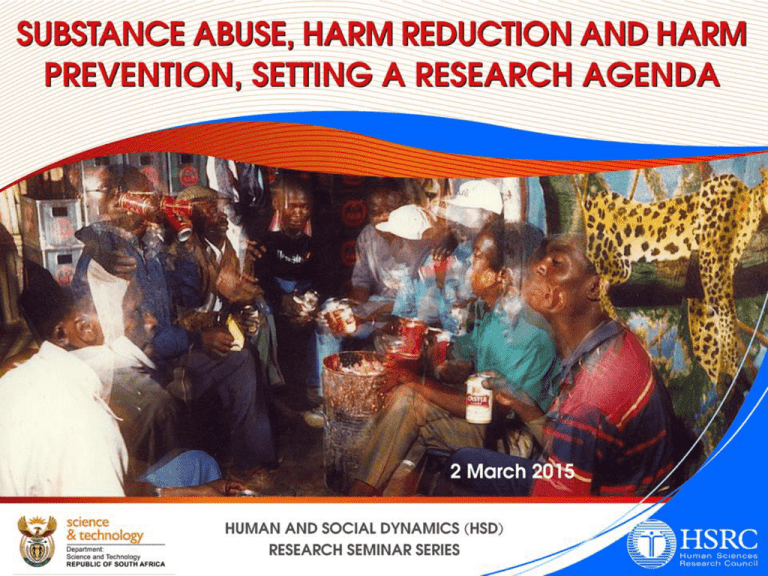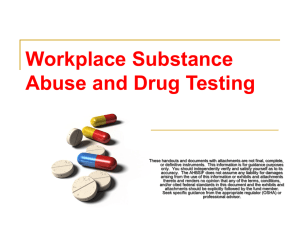
Social science that makes a difference
HUMAN AND SOCIAL
DYNAMICS RESEARCH
SEMINAR SERIES
SUBSTANCE ABUSE HARM
REDUCTION AND HARM
PREVENTION: SETTING A
RESEARCH AGENDA
THE EPIDEMIOLOGICAL PATTERN OF
SUBSTANCE ABUSE IN SA: THE NEED FOR
LONGITUDINAL SURVEYS AT POPULATION
LEVEL AND TARGET GROUPS
Professor Pamela Naidoo
Population Health, Health Systems & Innovation
(PHHSI): Human Sciences Research Council (HSRC),
South Africa, & Extraordinary Professor at the University of
the Western Cape (UWC)
pnaidoo@hsrc.ac.za
Townhouse Hotel, Cape Town, 2 March 2015
DEFINITIONS
In order to contextualize this presentation please note the
definition of each of the following key terms:
Substance Abuse: The National Drug Master Plan (20132017) [NDMP] developed by the Department of Social
Development defines substance abuse as: “The misuse
and abuse of legal or licit substances such as nicotine,
alcohol, over-the-counter and prescription medication,
alcohol concoctions, indigenous plants, solvents and
inhalants, as well as the use of illegal or illicit
substances” (p 19).
DEFINITIONS cont…
Surveys: “Are systematic methods for determining
how a sample of participants respond to a set of
standard questions attempting to assess their feelings,
attitudes, , beliefs, knowledge, risk-taking behaviours
and so on, at one or more times”
DEFINITIONS cont…
Population: A research population (target population)
is generally a large collection of individuals that is the
main focus of a scientific enquiry. Population level
research is usually done for the benefit of the
population.
Key Population: More vulnerable and most-at-risk
populations (e.g. youth and young adults; shift
workers; chronic pain sufferers)
INTRODUCTION
• Adequate evidence has been generated locally and
internationally to demonstrate the pervasive nature
and effect of substance abuse on individuals,
families, communities and the workplace
• The Cost of licit and illicit drug use is staggering (e.g.
illicit drug use cost the US an estimated $193 billion in
2007, and excessive alcohol use cost the US $223
billion in lost productivity, healthcare expenses, law
enforcement and criminal justice costs)
• In SA drug abuse is estimated to cost the
country R20 billion a year and combined
drug and alcohol abuse costs the
economy an estimated R130 billion a year
INTRODUCTION cont…
• Real and potential risks for substance abuse among key
populations such as adolescents and pregnant women,
vulnerable families and communities, and specific types
of paid work environments (such as shift work) need to
be identified through ‘best-practice’ methods such as
informed screening strategies
• We need data that informs us about the changing
trends of licit and illicit substance use and abuse
• Surveys are still the best method to answer key
research questions about the population at large and
about key populations
SURVEYS IN GENERAL
ADVANTAGES
• The survey method uses interviews, questionnaires, or
some combination of the two
• It’s versatile (chameleon-like): since the first stage of it’s
development in the 1930’s survey methods have
adapted to changes in society, exploiting new
technologies (e.g. internet-based technologies)
• Internet-based surveys offer low per respondent costs
and very fast turnaround of data records (among other
advantages)
SURVEYS IN GENERAL cont..
• Can be applied equally well to research with individuals,
groups, organizations, communities, or populations to
answer various research questions
• Prior to conducting a survey one should have a clear
idea of the following in order for the survey to be
considered good one :
Objectives: why (theory or policy behind the
research); what (the research question); who (study
sample), where (study site); and how (questions that need
to be answered before the study begins)
SURVEYS IN GENERAL cont..
• Another advantage is that surveys can use different
modes of administration for the data collection: face-to
face interviews, telephone interview, group selfcompletion and postal self-completion (or a combination
of these strategies)
• Despite disadvantages we still look for evidence in
numbers to guide decisions in government, health,
natural and social sciences and so on, so the demand
for survey statistics continues !
SURVEYS IN GENERAL cont..
•
•
•
•
DISADVANTAGES
Participation rates in household surveys are declining
Surveys seeking high response rates are experiencing
huge cost inflation
Traditional sampling frames are weakening. Alternate
sources of statistical information are driven by
technology based methods
Previously reliable modes of data collection have
changed since the 1990s: For e.g. telephone survey
frames declined in coverage because of the increase in
the number of mobile phone users
SURVEYS SPECIFIC TO SUBSTANCE USE AND
ABUSE
THE IMPORTANCE AND ADVANTAGES OF SURVEYS
• Our current knowledge about substance abuse misuse,
globally and nationally, comes primarily from
epidemiological surveys
• When surveys are well conducted using probability
sampling methods with large sample sizes, the smaller
the variance and the more precise the estimates of
population parameters (e.g. substance abuse rates)
SURVEYS SPECIFIC TO SUBSTANCE USE AND
ABUSE cont…
• Possible to combine data sets as illustrated by Orsi et
al (2010) using “scenario analysis” in a US communitybased substance use study in two communities with
different participation rates (one high and one low)
• Exploratory methods: Use hierarchical linear modelling
with combined data sets
It can get complicated…that’s when we use
statisticians !
SURVEYS SPECIFIC TO SUBSTANCE USE AND
ABUSE cont…
Methodological Failures
These following sources of error can contribute
directly to the failure of surveys:
• Sampling Errors: when a sample design is
constructed that leaves some element with a zero
probability of being selected, sampling error is
present
• Examples of commonly used non-probability, or
convenience sampling methodologies that are
being used in substance use epidemiology include
snowball sampling, venue sampling and respondent
driven sampling
SURVEYS SPECIFIC TO SUBSTANCE USE AND
ABUSE cont…
• Non-probability sampling methodologies are usually
used in “hard-to-reach” key populations such as illicit
drug users. This is a cost-effective method but it fails
to yield representative data
• Probability sampling methodologies using small
sample size are more likely to fail to produce precise
estimates of population characteristics
• Coverage errors: happens when sampling frames fail to
cover all persons to which inferences are made (e.g.
surveys of special populations such as trying to estimate
substance abuse among the homeless by sampling the
homeless currently living in shelters only)
SURVEYS SPECIFIC TO SUBSTANCE USE AND
ABUSE cont…
• Nonresponse: unwillingness or unavailability of
participants may underestimate substance abuse
behaviour
• Nonresponsive-ness in longitudinal substance abuse
surveys is common
• Measurement Errors: self-report data is often
inaccurate because many respondents report “socially
desirable” responses. Ideally biomarkers/toxicology
findings from assays of respondents hair, saliva, and
urine specimens should be collected. When self-report is
compared against biomarkers, respondents are found to
under-report the extent of substance abuse behaviour
SURVEYS SPECIFIC TO SUBSTANCE USE AND
ABUSE cont…
• Under-reporting of alcohol use, for example, can vary by
age, gender and consumption levels
• Other common measurement errors include: misunderstanding the questions, not following the skip
patterns
• Processing Errors: not accounting for missing data
• Conceptual Failures: failures of non-use; failures of
misuse; failure to anticipate new questions (such as
detecting new or emerging substance abuse patterns)
and ethical failures
Showcasing Global and Local Substance
Abuse Surveys
SURVEY: Differential Racial/Ethnic patterns in
Substance use initiation among young, low-income
women (US) (Wu et al, 2010). Conducted among 1831year olds
Knowledge gained: White women: initiated tobacco and
beer/wine at earlier ages and also more likely to use illicit
drugs at this point. African-American and Hispanic women
initiated tobacco and beer/wine at much later ages than
white women but were more likely to use illicit drugs
Value of findings: Has implications for intervention,
treatment and health promotion for this target group
Showcasing Global and Local Substance
Abuse Surveys cont…
SURVEY:National Survey of Drug Use and Health (USA)
Article based on survey report focussing on the
adolescent group (Ford et al, 2012)
Knowledge gained:Religiosity reduces the odds of
tobacco use, heavy drinking, prescription drug misuse,
marijuana use, and other illicit drug use
Value of findings: Influence of culture and religion on
substance use and abuse in this targeted age group. Once
again this has implications for prevention and intervention
programmes which may need to involve faith-based
organizations
Showcasing Global and Local Substance
Abuse Surveys cont…
SURVEY: A Survey of 100 Community Colleges on
Student Substance Use, Programming, and
Collaborations (US) (Chiauzzi et al, 2011)
Knowledge gained: Participants reported a number of
alcohol and other drug (AOD) related concerns. Despite
limited staff and funding dedicated to AOD, institutions are
implementing a number of programmes. They are also
collaborating with a number of on and off-campus groups
Value of findings: Substance Abuse Programmes can be
implemented using a collaborative approach (on and offsite) in this target group
Showcasing Global and Local Substance
Abuse Surveys cont…
SURVEY: South African National HIV, Incidence,
Behaviour and Communication survey (SABSSM)
(Shisana et al, 2009, 2014.) Article based on survey
conducted in 2008 (Peltzer et al, 2011)
Knowledge gained: alcohol drinking patterns (harmful and
hazardous) disaggregated for culture/race, age, sex, socioeconomic- status, education and location (urban-rural)
National data for 15 years and older
Value of findings: Has implications for prevention and
intervention programmes at population level
Showcasing Global and Local Substance
Abuse Surveys cont…
SURVEY: South African Stress and Health (SASH)
study
Article based on survey conducted in 2002-2004 (van
Heerdan et al, 2009)
Knowledge gained: use of alcohol, tobacco, and cannabis
disaggregated for culture/race, age and sex. Adult level
data
Value of findings: Has implications for prevention and
intervention programmes for adult target group
Showcasing Global and Local Substance
Abuse Surveys cont…
Survey: Leisure time, physical activity and sedentary
behaviour, and substance use among in-school
adolescents in eight African countries. Article based
on report focussing on 13-15 year olds (Peltzer al,
2010) Knowledge gained: Frequency of alcohol
consumption and higher SES were significantly associated
with leisure time physical activity, while tobacco, illicit drug
use, and mental health variables were not. Leisure time
sedentary behavior of five and more hours spent sitting on
a usual day were highly associated with all substance use
variables Value of findings: specific information for
targeted interventions in a key population
Showcasing Global and Local Substance
Abuse Surveys cont…
Survey: Survey on substance use, risk behavior and
mental health among grade 8-10 learners in schools in
the Western Cape province, 2011 (Morejele et al, 2011)
Knowledge gained: Provincial data on school-going
adolescents with respect to patterns and frequency of
substance use and abuse. Data gathered on alcohol,
tobacco, cannabis, methamphetamine and mandrax
Value of findings: Has implications for prevention and
intervention programmes for educational institutions. Also
helps to guide action plan across sectors (e.g. SAPS,
Social Development, Health and so on)
Showcasing Global and Local Substance
Abuse Surveys cont…
Survey: South African Demographic and Health Survey
(SADHS) (2003)
Knowledge gained: Patterns of alcohol and tobacco use
among adults. National level data
Value of findings: Has implications for prevention and
intervention programmes for department of health given
that alcohol and tobacco use present as risk factors for
cancer, CHD and so on. Also helps to guide action plan
across sectors
Showcasing Global and Local Substance
Abuse Surveys cont…
SURVEY: Adolescent Alcohol Use in rural South
African High Schools (Onya et al, 2012)
Knowledge gained: Gender differences in alcohol
consumption in rural areas with males 2.4 times more
likely to drink than females
Value of findings: specific information for targeted
interventions among adolescents in rural communities
Showcasing Global and Local Substance
Abuse Surveys cont…
Survey: The 3rd South African National Youth Risk
Behaviour Survey, 2011 (Reddy et al, 2013)
Knowledge gained: alcohol, tobacco, cannabis, inhalants,
mandrax, cocaine, heroin, club drugs, whoonga,
methamphetamine (tik), and over-the counter and
prescription drugs use and abuse among school going
grades 8-10 learners at National Level (disaggregated
for provincial level data)
Value of findings: Has implications for prevention, health
promotion and intervention programmes for a targeted
population. Also has policy implications
PROPOSED WAY FORWARD FOR RESEARCH
ON SUBSTANCE ABUSE HARM REDUCTION
AND HARM PREVENTION
• Need to improve survey designs
• Need to be innovative to capture epidemiological
patterns using technology-based solutions
• Surveys dedicated to substance use conducted
regularly every 3 to 5 years is a systematic way of
providing up-to-date and comprehensive information on
substance use and abuse
• Ideally data collected should be both biomarkers and
self-report data
• Data from population based surveys and key populations
will ultimately inform health, social and economic
policies
PROPOSED WAY FORWARD FOR RESEARCH
ON SUBSTANCE ABUSE HARM REDUCTION
AND HARM PREVENTION cont…
• Data from population based surveys and key populations
will also inform the development of new treatment
programmes and guide the modification of existing
ones across the country
• The epidemiological pattern of substance use and abuse
at Provincial Level is also important to enable the
development of context-specific prevention, treatment
and health promotion programmes. Will also guide intersectoral involvement (e.g. Education, SAPS, and so on)
THANK YOU
Pamela Naidoo: pnaidoo@hsrc.ac.za








